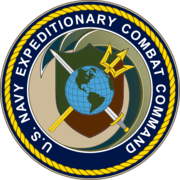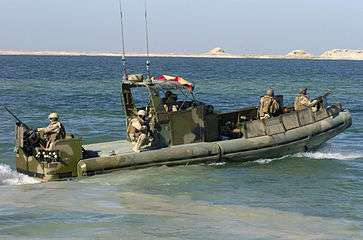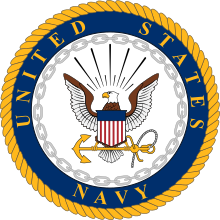Navy Expeditionary Combat Command
The Navy Expeditionary Combat Command (NECC) serves as the single functional command to centrally manage current and future readiness, resources, manning, training and equipping of the United States Navy's 21,000 expeditionary forces who are currently serving in every theater of operation. The NECC was established in January 2006.[1] NECC is a subordinate command of the Navy's Fleet Forces Command.
| Navy Expeditionary Combat Command | |
|---|---|
 The seal of the U.S. Navy Expeditionary Combat Command. | |
| Active | 2006 – present |
| Country | |
| Branch | |
| Size | 21,000 |
| Garrison/HQ | Joint Expeditionary Base Little Creek-Fort Story, Virginia Beach, U.S. |
| Engagements | Global War on Terrorism |
| Commanders | |
| Current commander | RDML Brian Brakke, USN |
NECC components offer functions such as command and control of expeditionary warfare operations, training, maritime and port security, logistics support, construction, littoral and coastal warfare and patrol, coastal riverine warfare, explosive ordnance disposal (EOD), expeditionary diving and combat salvage, and combat photography.
Purpose
NECC aligns disparate expeditionary capabilities to coordinate expeditionary practices, procedures and requirements in the joint battlespace. NECC integrates all warfighting requirements for expeditionary combat and combat support elements, consolidating and realigning the Navy's expeditionary forces under a single command to improve fleet readiness. NECC's goal is to improve efficiencies and effectiveness through economies of scale.
NECC changed how the U.S. Navy organizes, trains and equips its forces to meet the Maritime Security Operations and Joint contingency operations requirements. NECC is not a stand-alone or combat force, but rather a protection force that fills the gaps in the joint warfare arena and complements capabilities of foreign military partners. As an asset to operational commanders, NECC is designed to provide an array of capabilities that are unique to the expeditionary maritime environment as opposed to the blue water and land warfare environments.
NECC seamlessly operates with the other services and coalition partners to provide cooperative assistance as requested. This redistribution of support places naval forces where they are needed the most and establishes new capabilities in support of Maritime Security Operations.
Individual training and qualifications
Members of most NECC Commands are generally expected to seek qualification for the Enlisted Expeditionary Warfare Specialist Insignia. Unless they belong to specialized communities and training which require them to qualify for their respective badge such as Seabee Combat Warfare Badge, Navy Diving Badge or Navy Explosive Ordnance Disposal Badge.
Component commands of the NECC

The NECC's component commands included in January 2007:[2]
- Naval Construction Forces (NCF) or "Seabees"
- Expeditionary Combat Readiness Center (ECRC)
- Explosive Ordnance Disposal Group (EOD)
- Expeditionary Combat Camera, Norfolk (COMCAM)
- Navy Expeditionary Intelligence Command (NEIC)
- Navy Expeditionary Logistics Support Group
- Coastal Riverine Force (CORIVFOR)
- Mobile Diving and Salvage Units
- Expeditionary Warfighting Development Center (EXWDC)
On the 2007 "Navy Times" list of component commands was Maritime Civil Affairs. In May 2014 the Navy disestablished its only civil affairs formation, the Maritime Civil Affairs and Security Training Command (MCAST). McFate, writing in 2020, argued that the disestablishment of MCAST illustrated the Navy's relative prioritisation of partnerships and partnership building as opposed to combat capability.[3]
NECC in War on Terrorism
The United States Navy Riverine Squadrons of the United States Navy are elements of the NECC that have taken active part in the land operations in support of the Army and USMC units. According to the Navy: "The Navy's Riverine force focuses on conducting Maritime Security Operations and Theater Security Cooperation in a riverine area of operations or other suitable area. The force is capable of combating enemy riverine forces by applying fires directly, or by coordinating supporting fires. It will share battle space with the other Services in an effort to close the seams in Doctrine, Tactics, Techniques, and Procedures, and Command, Control, Communications, Computers, Intelligence, Surveillance and Reconnaissance."[4]
As of 2008, three riverine squadrons are active in the Navy, all under the command of Riverine Group 1, located in Norfolk, Virginia. Riverine Squadron 1 (RIVRON 1) deployed to Iraq in April 2007 and was relieved by Riverine Squadron 2 (RIVRON 2) in October 2007. Riverine Squadron 3 (RIVRON 3) was established in July 2007 and will presumably relieve RIVRON 2 in Iraq when their deployment is completed.
Other forces that support NECC
Conventional United States Marine Corps and US Navy entities:
- Fleet Marine Force (FMF), a component maritime military force that provides expeditionary and amphibious warfare (ship-to-shore beach landings), supported by appropriate U.S. Navy operational forces. Subordinate commands of the FMF, comprising the Marine Expeditionary Forces (MEF)—and its subordinate Marine Expeditionary Units (MEU)—are responsible in conflicts pertaining to littoral, and its adjacent areas (green-water naval support); the MEFs no longer provides conventional riverine missions (brown-water naval support), as it handed this function on to NECC.
Naval Special Warfare entities:
- Naval Special Warfare Group 11: SEAL Teams 17 & 18 (Operational Support Teams Navy Reserve )
- Special Boat Teams, who share the Navy's coastal, littoral, and riverine warfare heritage
- Special Boat Team 12 and SBT-20, who share the Navy's Coastal and littoral warfare heritage
- Special Boat Team 22, who share the Navy's riverine warfare heritage
United States Coast Guard entities:
- Deployable Operations Group, various units within Deployable Specialized forces can be sent under NECC Command or augment the forces.
- Naval Coastal Warfare, These Coast Guard units are part of an interoperable force and are part of the Department of Defense international and domestic security. They provide anti-terrorism / force protection for forward deployed base camps and ports around the world where needed. Coast Guard billets assigned to NCW Groups support directly Naval expeditionary combat command forces.
- Port Security Unit, PSU’s are the Reserve element under Maritime Expeditionary Security Forces (MESFs), within the Navy Expeditionary Combat Command structure.
See also
| Wikimedia Commons has media related to Navy Expeditionary Combat Command. |
- Deployable Operations Group, the U.S. Coast Guard equivalent of the NECC.
References
- "About Us". Retrieved 13 October 2008.
- "Year-old NECC tackles ever-growing list of jobs". Navy Times. 15 January 2007. Retrieved 13 October 2008.
- Montgomery McFate, "Being there: US Navy organisation culture and the forward presence debate," Defence and Security Analysis, Vol. 36, No. 1, 55.
- U.S. Navy Expeditionary Combat Command: “Riverine: About Us”
